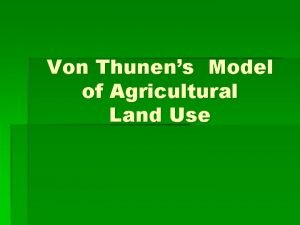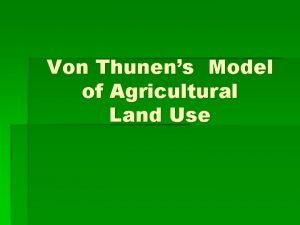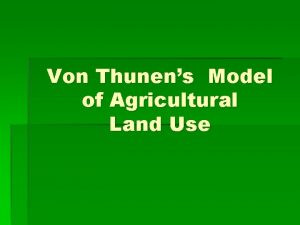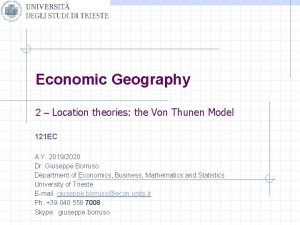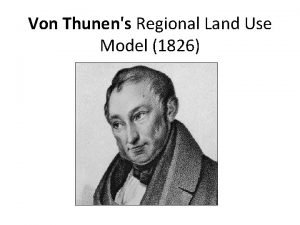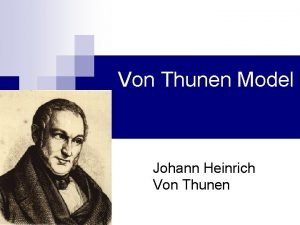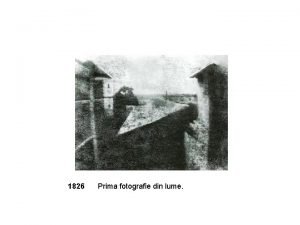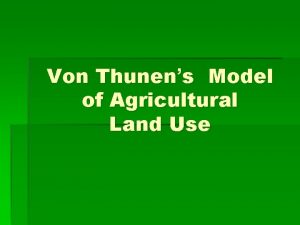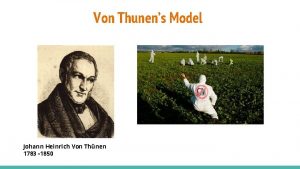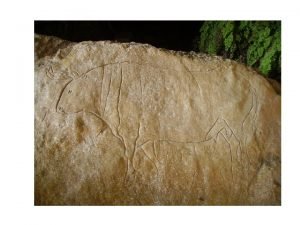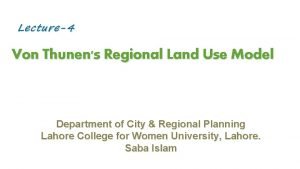Von Thunens Model 1826 O The city is









- Slides: 9

Von Thunen’s Model 1826

O The city is located centrally within an "Isolated State" which is self sufficient and has no external influences. O The Isolated State is surrounded by an unoccupied wilderness. O The land of the State is completely flat and has no rivers or mountains to interrupt the terrain. O The soil quality and climate are consistent throughout the State.

O Farmers in the Isolated State transport their own goods to market via oxcart, across land, directly to the central city. Therefore, there are no roads. O Farmers act to maximize profits.

In an Isolated State with the foregoing statements being true, Von Thunen hypothesized that a pattern of rings around the city would develop. O There are four rings of agricultural activity surrounding the city. O Dairying and intensive farming occur in the ring closest to the city. O Since vegetables, fruit, milk and other dairy products must get to market quickly, they would be produced close to the city (remember, we didn't have refrigerated oxcarts!)

O Timber and firewood would be produced for fuel and building materials in the second zone. O Before industrialization (and coal power), wood was a very important fuel for heating and cooking. O Wood is very heavy and difficult to transport so it is located as close to the city as possible.

O The third zone consists of extensive fields crops such as grains for bread. O Since grains last longer than dairy products and are much lighter than fuel, reducing transport costs, they can be located further from the city.

O Beyond the fourth ring lies the unoccupied wilderness, which is too great a distance from the central city for any type of agricultural product. O An excellent illustration of the balance between land cost and transportation costs. As one gets closer to a city, the price of land increases. The farmers of the Isolated State balance the cost of transportation, land, and profit and produce the most cost-effective product for market

O Significant improvements in transport technology took place since Von Thunen designed his agricultural land use model. O For instance with rail systems, it became much more cost effective to transport agricultural commodities over longer distances. O Further, refrigeration enabled to move perishable products cost-effectively over long distances. O Since most of the American agricultural landscape was established in the late 19 th and early 20 th century, agricultural land use was much less constrained by transport costs than its European and Asian counterparts. O Large scale agricultural regions thus emerged where agricultural land use was influence by distance from major markets and by local geographical conditions. O As such, it is possible to apply Von Thunen's assumption to agricultural land use over the continental United States.

O Figure A represents what the agricultural land use would be if the most basic assumptions were applied, namely the market located at New York (or Bost. Wash), crops being ranked by comparative rent paying abilities and considering ubiquitous geographical characteristics. Although this representation has some level of concordance with reality, it inaccurately portrays agricultural land use in the United States. O Figure B includes one supplementary assumption that considers climate variations, where the north is colder than the south. This constraint has a significant impact on agricultural land use as even if for a location a crop would have a higher rent paying ability, another crop would be grown because climatic conditions forbids it. The resulting agricultural land use has a much higher level of correspondence with reality.
